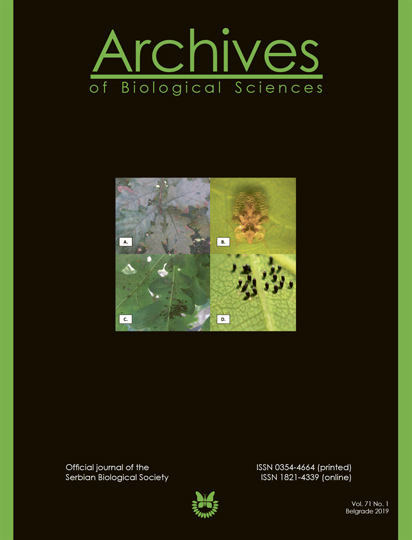Dynamic thiol/disulfide homeostasis in serum of patients with generalized vitiligo
Keywords:
generalized vitiligo, native thiol, disulfide, total thiol, homeostasisAbstract
Paper description:
- Changes in dynamic thiol/disulfide homeostasis in generalized vitiligo was confirmed.
- Native and total thiol contents were significantly lower in vitiligo patients.
- Disulfide/native thiol and disulfide/total thiol ratios were higher in vitiligo patients.
- Thiol/disulfide homeostasis was shifted toward disulfide formation.
- Progressivity of the disease strongly regulated the thiol/disulfide homeostasis.
Abstract: Vitiligo is a multifactorial disorder commonly associated with hypo-/depigmentation in the skin and may influence both children and adults psychologically because of the notable leopard-skin-like appearance. This study was designed to investigate the thiol/disulfide homeostasis in patients with generalized vitiligo and to determine its relationship with some of the demographical characteristics. Seventy-six generalized vitiligo patients and 67 healthy individuals were included in the study. Blood serum native thiol, disulfide and total thiol concentrations, together with some hematological parameters, were determined. Results demonstrated that native and total thiol contents, and their ratios, were significantly lower in vitiligo patients. Disulfide/native thiol and disulfide/total thiol ratios were significantly higher in the patient group. Progressivity of the disease strongly regulated the thiol/disulfide homeostasis in such a way that active vitiligo patients had reduced native and total thiol levels but increased disulfide/native thiol and disulfide/total thiol ratios. Moreover, there was a statistically significant negative correlation between both duration of the vitiligo and native and total thiol contents. As these results clearly demonstrated that thiol/disulfide homeostasis was shifted toward disulfide formation in patients with generalized vitiligo, determining the dynamic nature of thiol/disulfide homeostasis can be used to monitor disease progression.
https://doi.org/10.2298/ABS181003047P
Received: October 3, 2018; Revised: October 8, 2018; Accepted: October 9, 2018; Published online: October 10, 2018
How to cite this article: Pektaş G, Pektaş SD, Öztekin A, Öztekin C, Neşelioğlu S, Erel Ö, Sadi G. Dynamic thiol/disulfide homeostasis in serum of patients with generalized vitiligo. Arch Biol Sci. 2019;71(1):55-62.
Downloads
References
Rashighi M, Harris JE. Vitiligo Pathogenesis and Emerging Treatments. Dermatol Clin. 2017;35(2):257-65.
Speeckaert R. Vitiligo: An Update on Pathophysiology and Treatment Options. Am J Clin Dermatol. 2017;18(6):733-44.
Oliveira PVS, Laurindo FRM. Implications of plasma thiol redox in disease. Clin Sci. 2018;132(12):1257-80.
Biswas S, Chida AS, Rahman I. Redox modifications of protein-thiols: Emerging roles in cell signaling. Biochem Pharmacol. 2018;71(5):551-64.
Ates I, Ozkayar N, Inan B, Yilmaz FM, Topcuoglu C, Neselioglu S, Erel O, Dede F, Yilmaz N. Dynamic thiol/disulphide homeostasis in patients with newly diagnosed primary hypertension. J Am Soc Hypertens. 2016;10(2):159-66.
Milton NGN. Homocysteine Inhibits Hydrogen Peroxide Breakdown by Catalase. Open Enzym Inhib J. 2008;1:34-41.
Kishida R, Kasai H, Aspera SM, Arevalo RL, Nakanishi H. Branching Reaction in Melanogenesis: The Effect of Intramolecular Cyclization on Thiol Binding. J Electron Mater. 2017;46(6):3784-8.
Jara JR, Aroca P, Solano F, Martinez JH, Lozano JA. The role of sulfhydryl compounds in mammalian melanogenesis: the effect of cysteine and glutathione upon tyrosinase and the intermediates of the pathway. BBA - Gen Subj. 1988;967(2):296-303.
Erel O, Neselioglu S. A novel and automated assay for thiol/disulphide homeostasis. Clin Biochem. 2014;47(18):326-32.
Whitton ME, Pinart M, Batchelor J, Leonardi-Bee J, González U, Jiyad Z, Eleftheriadou V, Ezzedine K. Interventions for vitiligo. Cochrane Database Syst Rev. 2015;24(2):CD003263.
Taïeb A. Intrinsic and extrinsic pathomechanisms in vitiligo. Pigment cell Res. 2000;13(8):41-7.
Shi M-H, Wu Y, Li L, Cai Y-F, Liu M, Gao X-H, Chen ED. Meta-analysis of the association between vitiligo and the level of superoxide dismutase or malondialdehyde. Clin Exp Dermatol. 2017;42(1):21-9.
Jain A, Mal J, Mehndiratta V, Chander R, Patra SK. Study of Oxidative Stress in Vitiligo. Indian J Clin Biochem. 2011;26(1):78.
Qiu L, Song Z, Setaluri V. Oxidative Stress and Vitiligo: The Nrf2-ARE Signaling Connection. J Invest Dermatol. 2014;134(8):2074-6.
Karsli N, Akcali C, Ozgoztasi O, Kirtak N, Inaloz S. Role of oxidative stress in the pathogenesis of vitiligo with special emphasis on the antioxidant action of narrowband ultraviolet B phototherapy. J Int Med Res. 2014;42(3):799-805.
Turell L, Radi R, Alvarez B. The thiol pool in human plasma: The central contribution of albumin to redox processes. Free Radic Biol Med. 2013;65:244-53.
Vogel C, Silva GM, Marcotte EM. Protein expression regulation under oxidative stress. Mol Cell Proteomicst. 2011;10(12):M111.009217.
Pandey KB, Mehdi MM, Maurya PK, Rizvi SI. Plasma protein oxidation and its correlation with antioxidant potential during human aging. Dis Markers. 2010;29(1):31-6.
Akoglu G, Neselioglu S, Karaismailoglu E, Aktas A, Erel O. Plasma Thiol Levels are Associated with Disease Severity in Nonsegmental Vitiligo. Indian J Dermatol. 2018;63(4):323-7.
Koyasu S, Moro K. Role of innate lymphocytes in infection and inflammation. Front Immunol. 2012;3:101
Downloads
Published
How to Cite
Issue
Section
License
Authors grant the journal right of first publication with the work simultaneously licensed under a Creative Commons Attribution 4.0 International License that allows others to share the work with an acknowledgment of the work’s authorship and initial publication in this journal.




